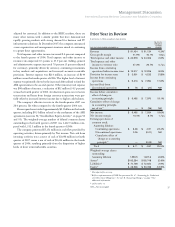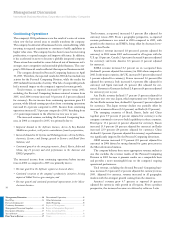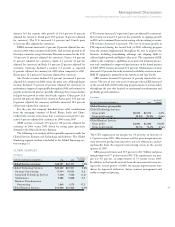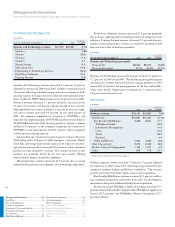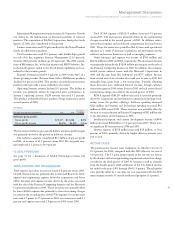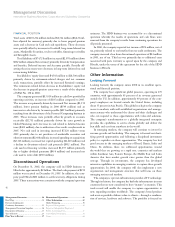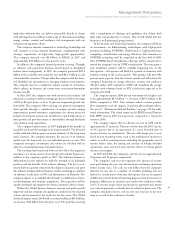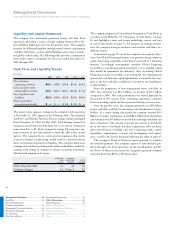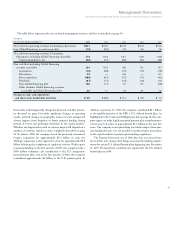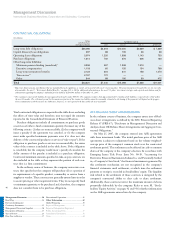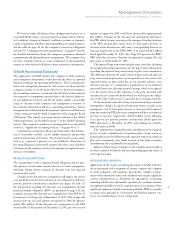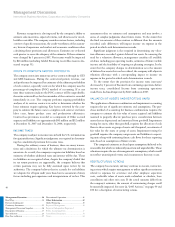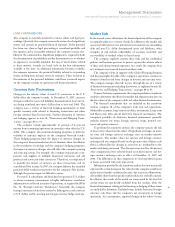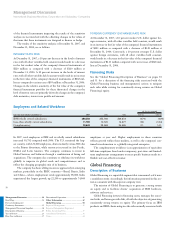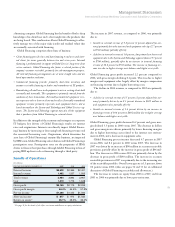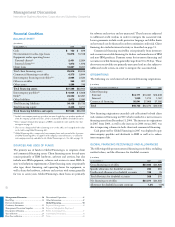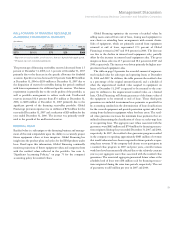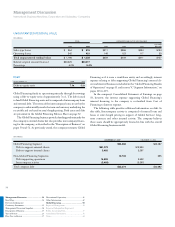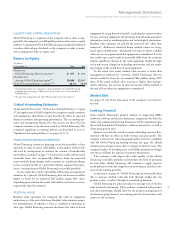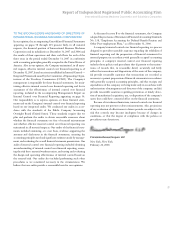IBM 2007 Annual Report Download - page 49
Download and view the complete annual report
Please find page 49 of the 2007 IBM annual report below. You can navigate through the pages in the report by either clicking on the pages listed below, or by using the keyword search tool below to find specific information within the annual report.Management Discussion
International Business Machines Corporation and Subsidiary Companies
47
We have no other off-balance sheet arrangements that has, or is
reasonably likely to have, a material current or future effect on finan-
cial condition, changes in financial condition, revenues or expenses,
results of operations, liquidity, capital expenditures or capital resources.
See the table on page 46 for the company’s contractual obligations
and note N, “Contingencies and Commitments,” on pages 95 and 96,
for detailed information about the company’s guarantees, financial
commitments and indemnification arrangements. The company does
not have retained interests in assets transferred to unconsolidated
entities or other material off-balance sheet interests or instruments.
Critical Accounting Estimates
The application of GAAP requires the company to make estimates
and assumptions about future events that directly affect its reported
financial condition and operating performance. The accounting esti-
mates and assumptions discussed in this section are those that the
company considers to be the most critical to its financial statements.
An accounting estimate is considered critical if both (a) the nature of
the estimates or assumptions is material due to the levels of subjectiv-
ity and judgment involved, and (b) the impact within a reasonable
range of outcomes of the estimates and assumptions is material to
the company’s financial condition or operating performance. Senior
management has discussed the development, selection and disclosure
of these estimates with the Audit Committee of the company’s Board
of Directors. The critical accounting estimates related to the Global
Financing business are described on page 55 in the Global Financing
section. The company’s significant accounting policies are described
in note A, “Significant Accounting Policies,” on pages 64 to 73.
A quantitative sensitivity analysis is provided where that informa-
tion is reasonably available, can be reliably estimated and provides
material information to investors. The amounts used to assess sensi-
tivity (e.g., 1 percent, 5 percent, etc.) are included to allow users of
the Annual Report to understand a general direction cause and effect
of changes in the estimates and do not represent management’s pre-
dictions of variability.
PENSION ASSUMPTIONS
The measurement of the company’s benefit obligation and net peri-
odic pension cost/(income) requires the use of certain assumptions,
including, among others, estimates of discount rates and expected
return on plan assets.
Changes in the discount rate assumptions will impact the service
cost, (gain)/loss amortization and interest cost components of the net
periodic pension cost/(income) calculation (see pages 111 and 112
for information regarding the discount rate assumptions) and the
projected benefit obligation (PBO). As presented on page 111, the
company increased the discount rate assumption for the PPP by 25
basis points to 6.00 percent on December 31, 2007. This change will
decrease pre-tax cost and expense recognized in 2008 by approxi-
mately $65 million. If the discount rate assumption for the PPP
decreased by 25 basis points on December 31, 2007, pre-tax cost and
expense recognized in 2008 would have increased by approximately
$65 million. Changes in the discount rate assumptions will impact
the PBO which, in turn, may impact the company’s funding decisions
if the PBO exceeds plan assets. Each 25 basis point increase or
decrease in the discount rate will cause a corresponding decrease or
increase, respectively, in the PPP’s PBO of an estimated $1.2 billion
based upon December 31, 2007 data. Page 109 presents the PPP’s
PBO (after the increase in discount rate presented on page 111) and
plan assets as of December 31, 2007.
The expected long-term return on plan assets is used in calculating
the net periodic pension (income)/cost. See page 112 for information
regarding the expected long-term return on plan assets assumption.
The differences between the actual return on plan assets and expected
long-term return on plan assets are recognized over five years in the
expected return on plan assets line in net periodic pension cost/
(income) and also as a component of gains/losses in Accumulated
gains and (losses) not affecting retained earnings, which is recognized
over the service lives of the employees in the plan, provided such
amounts exceed certain thresholds which are based upon the obliga-
tion or the value of plan assets, as provided by accounting standards.
To the extent the outlook for long-term returns changes such that
management changes its expected long-term return on plan assets
assumption, each 50 basis point increase or decrease in the expected
long-term return on PPP plan assets assumption will have an estimated
decrease or increase, respectively, of $249 million on the following
year’s pre-tax net periodic pension cost/(income) (based upon the
PPP’s plan assets at December 31, 2007 and assuming no contribu-
tions are made in 2008).
The company may voluntarily make contributions or be required,
by law, to make contributions to its pension plans. Actual return on
pension plan assets that differ from the expected long-term return on
plan asset assumptions, may result in more or less future company
contributions than is planned by management.
Impacts of these types of changes on the company’s pension plans
in other countries worldwide will vary depending upon the status of
each respective plan.
REVENUE RECOGNITION
Application of the various accounting principles in GAAP related to
the measurement and recognition of revenue requires the company
to make judgments and estimates. Specifically, complex arrange-
ments with nonstandard terms and conditions may require significant
contract interpretation to determine the appropriate accounting,
including whether the deliverables specified in a multiple element
arrangement should be treated as separate units of accounting. Other
significant judgments include determining whether IBM or a reseller
is acting as the principal in a transaction and whether separate con-
tracts are considered part of one arrangement.


